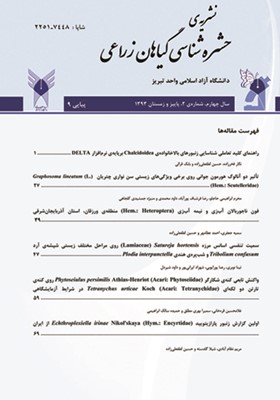خسارت حلزون سفید (Helicella candeharica) در نهالستانهای زیتون منطقهی طارم رودبار، شمال ایران
محورهای موضوعی : حشره شناسی گیاهان زراعی
کلید واژه: ایران, حلزون سفید, Helicella candeharica, نهالستان زیتون, طارم رودبار,
چکیده مقاله :
حلزون سفید Helicella candeharica (L. 1864) در سالهای 1388و 1389 در زیتونکاریهای منطقهی طارم رودبار استان گیلان خسارت طغیانی داشت. تعداد زیادی از افراد این گونه در نهالستانهای زیتون روی علفهای هرز و نهالهای زیتون جمعآوری گردید. خسارت شدید روی تمامی اندامهای نهالهای زیتون و برگ، ساقه و بذور گونههای مختلف علفهای هرز تیرههای مختلف در سطح 400 الی 500 هکتار دیده شد. خسارت عمدتاً به صورت تغذیه از برگ های جوان و پوستهی ساقهی نهالهای زیتون بود. همچنین این گونه با ایجاد استرس در نهالها و درختان زیتون، موجب برگریزی و کاهش فتوسنتز میشود. علفهای هرز مأمن مناسبی برای این گونه به شمار می روند و تعداد زیادی از تخمها و لاروها در دو الی پنج سانتی متری سطح خاک و نمونههای بالغ روی اندامهای مختلف علفهای هرز مشاهده شدند. همچنین تراکم آفت در نهالستان زیتون نشان داد که بیشترین تراکم جمعیت در ماههای اردیبهشت (با میانگین 1/5 ± 1/57) و آبان (با میانگین 4/7 ± 60) و کمترین آن در ماه بهمن (با میانگین 5/0± 5) بوده است.
Collecting and identification of Helicella candeharicaon olive seedlings as along with of its weed hosts in Tarom-e Roodbar (North of Iran) was investigated during 2009–2010. Remarkable damage of the pest on olive seedlings and an outbreak on allied weed species, belonging to several families, in more than 500 hectares of orchards in Tarom-e Roodbar was evaluated. The majority of feeding activity was observed on young leaves (except for midribs). The bark of the olive shoots was also eaten that caused retardation of seedling growth. The damage might also make stress through defoliation and decreasing photosynthesis. Huge occurrence of snail population on the infested olive orchards gives the impression of being white appearance on plants and soil. The maximum population density was recoded as 57.1±5.1 in April and 60±7.4 in October; though, the minimum population density was 5±0.5 in February.
Barker GM. 2002. Molluscs as crop pests. CABI Publishing. 468.
Fisher T, Orth RE 1985. Differential mortality of garden snails to metaldehyde. California Agriculture, 29(6):7-10.
Ghahreman A. 1978 to 2004. Flora of Iran. Research Institute of Forests and Rangelands.
Godan D. 1987. Pest slugs and snails (biology & control). Pringer-Verlag, Publ. Berlin, 445.
Likharev IM, Rammel Meier ES. 1962. Terrestrial mollusks of the fauna of the U.S.S.R. Israel program for scientific translation Jerusalem.
Mirzaei A. 1972. Molluscs of agricultural pest in Iran. Plant Pests and Diseases Research Institute, Ministry of Agriculture and Natural Resources. 68.
Pappas JL, Carman GE. 1961. Control of European brown snail in citrus groves in southern California with guthion and methaldehyde sprays. Journal of Economic Entomology, 54: 152-156.
Rechinger KH. 1990. Flora Iranica Akademishe Druck, Austria.
Sakovich N, Bailey B. 1985. Skirt pruning and tree banding as snail controls. Citrograph, 70: 18-21.
van Dinther J. 1973. Molluscs in agriculture and their control. Medical Entomology Laboratory. Wageningen, 232: 281-286.

